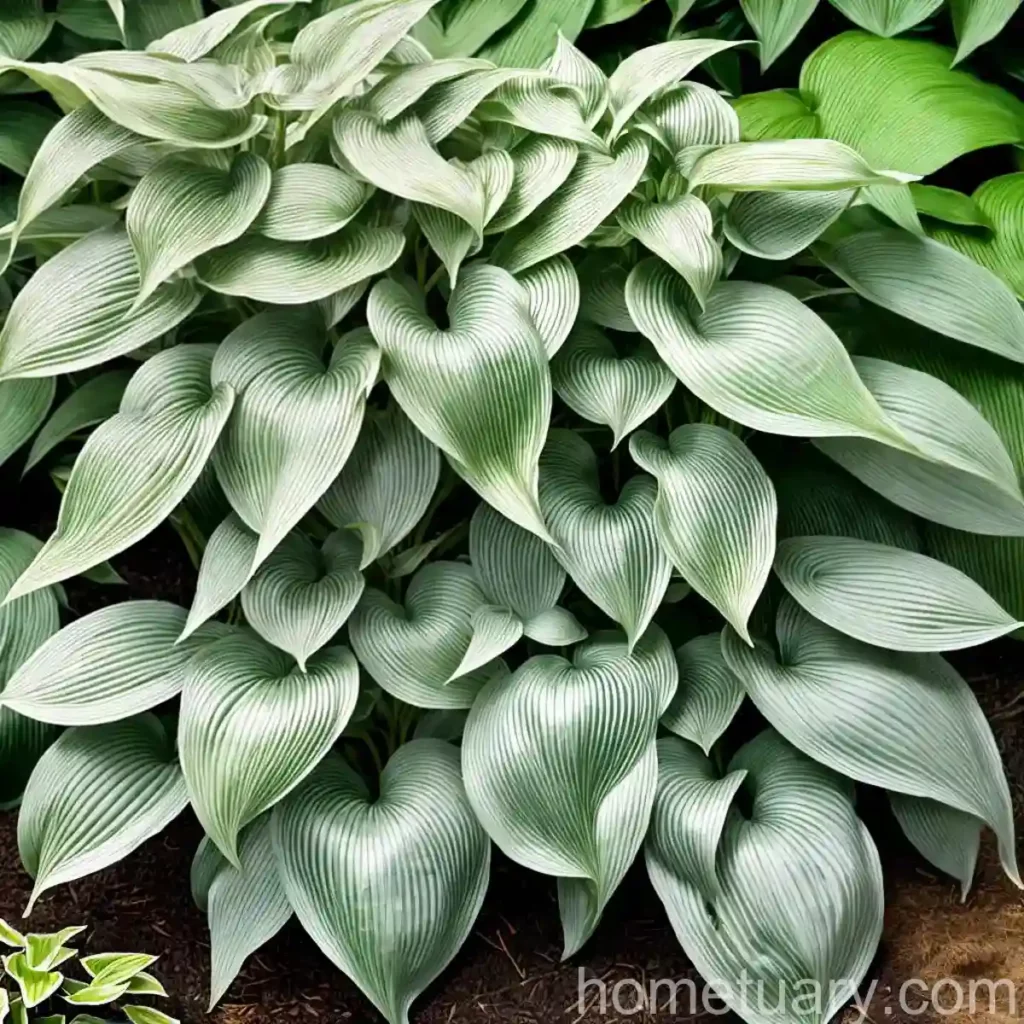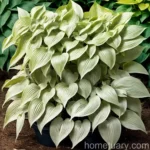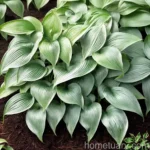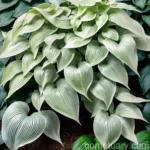Understanding the Beauty of Hosta (Hosta (Tardiana Group) ‘Hadspen Hawk’)
Plants have always held a special fascination for humanity through their beauty, diversity, and ecological significance. Among these, hosta (Hosta (Tardiana Group) ‘Hadspen Hawk’) stands out due to its elegant appearance and ease of cultivation. In this comprehensive guide, we will delve into the various aspects of this captivating plant, from its cultural requirements to its uses, and from its propagation to its susceptibility to diseases and pests.
What is Hosta (Hosta (Tardiana Group) ‘Hadspen Hawk’)?
Hosta (Tardiana Group) ‘Hadspen Hawk’ is a member of the plantain lily family, Asparagaceae, renowned for its striking foliage and delicate flowers. This perennial herbaceous plant is a cultivar within the Tardiana Group of hostas, characterized by its compact size, lustrous leaves, and lavender-hued flowers.
Hostas in general are native to Japan, China, and Korea, where they thrive in the shade of moist woodlands, complementing the cool and serene ambiance with their lush foliage. The specific epithet ‘Hadspen Hawk’ alludes to the plant’s origin from the renowned Hadspen Garden in Somerset, England, where the cultivar was first observed and named.

The Tardiana Group, to which ‘Hadspen Hawk’ belongs, is known for its numerous remarkable varieties, admired for their adaptability, diversity, and resilience. Hostas from this group are prized by gardeners and landscapers worldwide for their exceptional ornamental value and tolerance to varying conditions.
Key Takeaways – Hosta (Hosta (Tardiana Group) ‘Hadspen Hawk’)
Before we dive into the details of cultivating and caring for Hosta (Tardiana Group) ‘Hadspen Hawk’, let’s summarize the essential characteristics and considerations associated with this appealing plant:
- Plant Size: Compact, reaching a height of about 12 inches and a spread of 24 inches.
- Foliage: Glossy, heart-shaped leaves with prominent veins, adorned with irregular blue-green margins.
- Flowers: Bell-shaped, lavender-hued flowers bloom on slender scapes in midsummer, adding a touch of elegance to the plant’s appearance.
- Cultural Requirements: Thrives in partial to full shade, requires moist and well-drained soil, and benefits from regular watering and fertilization.
- Uses: Ideal as a ground cover, border plant, or accent in shaded gardens and landscapes, renowned for its aesthetic appeal and low maintenance.
- Popularity: Widely admired by gardeners for its adaptability, resilience, and graceful demeanor, rendering it a sought-after addition to gardens worldwide.
With the fundamental attributes of Hosta (Tardiana Group) ‘Hadspen Hawk’ outlined, let’s delve into each aspect of its cultivation and maintenance to ensure optimal growth and a thriving presence in our green spaces.
Culture
Cultivating Hosta (Tardiana Group) ‘Hadspen Hawk’ is a rewarding endeavor, especially when the plant’s cultural requirements are met with precision. Let’s explore the key considerations for nurturing this exquisite hosta variety.
Uses
As we embark on exploring the cultural facets of Hosta (Tardiana Group) ‘Hadspen Hawk’, it’s crucial to recognize the multiple roles this plant can play in the realm of garden design and landscaping. Its uses extend far beyond mere aesthetics, encompassing functional and ornamental purposes.
Ornamental Value
The most prominent use of Hosta (Tardiana Group) ‘Hadspen Hawk’ lies in its ornamental appeal, which stems from the striking contrast between its glossy, variegated leaves and the delicate, lavender flowers that adorn slender scapes in the summer. Its compact size makes it an excellent candidate for borders, rock gardens, and containers, where its vibrant foliage and blooms can enliven the surrounding space.
Ground Cover
The dense foliage of Hosta (Tardiana Group) ‘Hadspen Hawk’ lends itself well to the role of ground cover in shaded or woodland gardens. Its ability to form a lush carpet of variegated leaves adds depth and texture to the landscape while suppressing weed growth and conserving soil moisture.
Accent Plant
In addition to its application as a ground cover, Hosta (Tardiana Group) ‘Hadspen Hawk’ can serve as an eye-catching accent in shaded or partially shaded areas, drawing attention with its distinctive foliage and graceful blooms. Planted in proximity to other shade-loving perennials, it can contribute to the overall visual appeal of the garden, adding a touch of finesse to the composition.
Water
The water requirements of Hosta (Tardiana Group) ‘Hadspen Hawk’ are intricately tied to its preference for shaded environments and its need for moist soil. Adequate and consistent moisture is integral to the plant’s well-being, especially during the active growing season and periods of prolonged heat or dryness.
Watering Guidelines
- Frequency: While Hosta (Tardiana Group) ‘Hadspen Hawk’ is relatively resilient, it thrives when provided with regular watering. During the growing season, aim to water the plant deeply once or twice a week, ensuring that the soil remains consistently moist but not waterlogged.
- Irrigation: In the absence of rainfall, supplement natural moisture with a gentle, thorough watering session to penetrate the soil and reach the plant’s roots. Avoid overhead watering, as this can lead to fungal diseases and foliar issues.
- Mulching: Application of a layer of organic mulch around the base of the plant can help conserve soil moisture, regulate temperature, and inhibit weed growth. Additionally, it contributes to the aesthetic appeal of the planting area.
Sunlight
Hosta (Tardiana Group) ‘Hadspen Hawk’ is renowned for its preference for shaded or partially shaded locations, where the indirect or filtered sunlight contributes to the development of its vibrant foliage and flowering potential.
Light Requirements
- Partial Shade: Ideally, position Hosta (Tardiana Group) ‘Hadspen Hawk’ in a location that receives dappled sunlight or partial shade. An area that is shielded from the intense midday sun, such as under the canopy of deciduous trees or in proximity to structures, is conducive to the plant’s well-being.
- Filtered Light: In the absence of partial shade, Hosta (Tardiana Group) ‘Hadspen Hawk’ can also thrive in areas with filtered light or indirect sunlight. The gentle illumination enhances the color and texture of the foliage while preventing sun scorch.
Fertilizer
Providing adequate nutrients to Hosta (Tardiana Group) ‘Hadspen Hawk’ is vital for sustaining its vigor, promoting healthy growth, and enhancing its ornamental appeal. Proper fertilization can significantly influence the plant’s foliar abundance, coloration, and flowering capacity.
Fertilization Regimen
- Type: Utilize a balanced, slow-release fertilizer with an NPK ratio of 10-10-10 or a formulation specifically designed for shade-loving perennials. This ensures a steady supply of essential nutrients without the risk of overwhelming the plant with excess fertilizer salts.
- Schedule: Initiate fertilization in early spring, preferably before the emergence of new growth. Administer a granular or liquid fertilizer according to the manufacturer’s guidelines, and consider reapplication in midsummer to fuel the plant’s blooming phase.
Soil
The soil composition and structure directly influence the growth, development, and overall health of Hosta (Tardiana Group) ‘Hadspen Hawk’. Tailoring the soil conditions to match the plant’s preferences is crucial for unlocking its full potential.
Soil Requirements
- Moisture Retention: Hosta (Tardiana Group) ‘Hadspen Hawk’ thrives in well-drained soil that retains moisture without becoming waterlogged. A loamy, humus-rich substrate with good water retention capacity is ideal for sustaining the plant’s hydration requirements.
- Acidity: The plant favors slightly acidic to neutral soil with a pH range of 6.0 to 7.5. Conduct a soil test to gauge the pH of the planting site, and amend the soil as necessary to achieve the optimal range for Hosta (Tardiana Group) ‘Hadspen Hawk’.
- Aeration: Adequate soil aeration is essential for the development of healthy roots and the prevention of waterlogged conditions. Incorporate organic matter such as compost or well-rotted manure to enhance soil structure and promote root vitality.
Pruning
Pruning plays a pivotal role in maintaining the aesthetic appeal, vigor, and longevity of Hosta (Tardiana Group) ‘Hadspen Hawk’. By engaging in timely pruning practices, gardeners can mitigate the risk of disease, enhance air circulation, and rejuvenate the plant for renewed growth.
Pruning Guidelines
- Foliage Cleanup: Throughout the growing season, periodically remove discolored, damaged, or decaying leaves to uphold the plant’s visual charm and prevent the spread of fungal pathogens. Employ sanitized pruners to execute precise cuts without causing unnecessary stress to the plant.
- Flower Removal: Once the blooms have faded, snip off the spent flower stems to redirect the plant’s energy towards leaf production and underground storage structures. Clipping away the flowering stalks also prevents the formation of seed pods, which can divert resources and diminish the plant’s vigor.
Propagation
The propagation of Hosta (Tardiana Group) ‘Hadspen Hawk’ offers an opportunity to expand the plant’s presence within the garden or to share its beauty with fellow gardening enthusiasts. Understanding and leveraging the various propagation methods can facilitate the successful multiplication of this prized hosta variety.
Propagation Techniques
- Division: Dividing mature hosta clumps in early spring or late summer presents a simple and effective method for propagation. Using a sharp spade, carefully separate the rhizomes into smaller sections, each containing viable stems and root systems. Replant the divisions in prepared soil, ensuring adequate moisture and protection from direct sun.
- Seed Sowing: While not commonly practiced due to the variability in seedling traits, propagation via seeds is feasible with careful selection and nurturing of the resulting plants. Harvest mature seeds from the plant in late summer, and sow them in a seed-starting mix. Provide consistent moisture and shelter the emerging seedlings until they attain sufficient size for transplantation.
Container Popularity
Hosta (Tardiana Group) ‘Hadspen Hawk’ possesses a distinct allure that transcends traditional garden settings, making it an increasingly popular choice for container gardening. The compact dimensions, vibrant foliage, and manageable cultural requirements position it as an ideal candidate for container cultivation.
Container Considerations
- Selection: Choose a spacious, well-draining container with adequate depth to accommodate the plant’s root system and support its upward growth. Opt for materials such as terracotta, resin, or wood that offer breathability and insulation against temperature fluctuations.
- Soil Mix: Prepare a potting mix composed of peat moss, perlite, and compost to provide a balanced blend of moisture retention, aeration, and nutrient availability. Afford the plant a growth medium that mimics the qualities of its preferred natural habitat.
- Placement: Position the container in a shaded or partially shaded location, shielding it from the intense midday sun to prevent moisture loss and heat stress. Consider elevating the pot on feet or casters to promote air circulation and discourage waterlogging.
Common Diseases
While Hosta (Tardiana Group) ‘Hadspen Hawk’ is generally resilient, it is susceptible to certain diseases that can compromise its vitality and aesthetic appeal. Familiarizing oneself with these potential ailments and observing preventive measures is essential for safeguarding the plant’s well-being.
Disease Susceptibility
- Fungal Diseases: Hostas, including Hosta (Tardiana Group) ‘Hadspen Hawk’, are prone to fungal infections such as hosta virus X (HVX), root rot, and leaf spot. These pathogens thrive in humid, overcrowded conditions and can result in discoloration, deformities, and diminished vigor.
- Pest Damage: While not diseases per se, infestations by pests such as slugs, snails, and deer can inflict significant harm on the foliage and flowering structures of Hosta (Tardiana Group) ‘Hadspen Hawk. Employing control measures such as physical barriers, organic repellents, and vigilant monitoring is crucial for averting pest-related damage.
Disease Management
- Cultural Practices: Promote air circulation, reduce humidity, and space out plantings to discourage the onset and spread of fungal diseases. Remove and dispose of infected plant debris to prevent the recurrence of pathogens in subsequent seasons.
- Preventive Treatments: Utilize fungicidal sprays or drenches as a pre-emptive measure against fungal diseases, applying them in accordance with the manufacturer’s instructions and recommended frequency. Consider natural or organic fungicides to minimize the impact on beneficial organisms and the surrounding environment.
Common Pests
Alongside the potential for disease, Hosta (Tardiana Group) ‘Hadspen Hawk’ faces the risk of infestations by a variety of pests that can compromise its visual appeal and disrupt its growth. Identifying these common pests and implementing appropriate interventions is crucial for preserving the plant’s health and vitality.
Pest Profile
- Slugs and Snails: These herbivorous mollusks pose a significant threat to Hosta (Tardiana Group) ‘Hadspen Hawk due to their nocturnal feeding habits and voracious appetite for tender foliage. Their presence is often indicated by irregular holes and slimy trails on the leaves.
- Deer: In areas with high deer populations, Hosta (Tardiana Group) ‘Hadspen Hawk’ is vulnerable to browsing damage, as deer find the tender, succulent foliage irresistible. Fencing and deterrents are essential for protecting the plant from deer-related harm.
Pest Management
- Physical Barriers: Install barriers such as copper tape, diatomaceous earth, or coffee grounds around the base of Hosta (Tardiana Group) ‘Hadspen Hawk’ to deter slugs and snails, preventing them from reaching the foliage. Regularly inspect and reset the barriers to maintain their efficacy.
- Repellents: Deploy natural repellents or deterrents to dissuade deer from approaching the plant, such as foul-smelling sprays, motion-activated devices, or strategically placed plantings that are unappealing to deer.
Botanist’s Tips
Drawing from the expertise of botanists and horticulturists, the following tips can serve as valuable insights for cultivating and appreciating Hosta (Tardiana Group) ‘Hadspen Hawk’:
- Enhanced Drainage: Amend heavy or compacted soil with organic matter to enhance drainage and aeration, creating an optimal substrate for Hosta (Tardiana Group) ‘Hadspen Hawk’ to thrive.
- Companion Planting: Pair Hosta (Tardiana Group) ‘Hadspen Hawk’ with shade-loving companions such as ferns, astilbes, and heucheras to construct a harmonious and visually appealing shaded garden bed.
- Leaf Protection: Employ physical barriers or repellents to safeguard the foliage from pest damage, preempting issues before they escalate and compromise the plant’s aesthetic allure.
- Seasonal Adjustments: Monitor the plant’s water and fertilizer needs seasonally, adapting the care regimen to accommodate fluctuations in temperature, precipitation, and daylight duration.
Fun Facts
Fascinating Tidbits About Hosta (Tardiana Group) ‘Hadspen Hawk’
- The unique variegation and waxy texture of Hosta (Tardiana Group) ‘Hadspen Hawk’ leaves make them highly resistant to damage from slugs and snails, a common detriment to other hosta varieties.
- The specific epithet ‘Tardiana’ in the plant’s botanical name pays homage to its originator, Mr. E. M. E. H. Elslager, who specialized in the cultivation and selection of hostas.
- Hosta (Tardiana Group) ‘Hadspen Hawk’ exemplifies exceptional cold tolerance, thriving in temperate climates and exhibiting resilience in the face of frost and chilly conditions.
Links to External Resources
For further exploration and in-depth information on Hosta (Hosta (Tardiana Group) ‘Hadspen Hawk’), refer to the following external resources:
In conclusion, Hosta (Hosta (Tardiana Group) ‘Hadspen Hawk’) stands as an emblem of grace, resilience, and aesthetic allure within the realm of shade-loving perennials. By comprehensively understanding and satisfying its cultural requirements, protecting it from potential threats, and celebrating its ornamental merit, gardeners can ensure the enduring presence of this captivating hosta variety in their green spaces.















